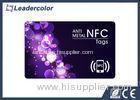

Plastic Anti Metal NFC Tags IS014443A Standard with Ntag203 Chip
| Place of Origin: | Zhejiang |
|---|
Company Profile
| Location: | Shenzhen, Guangdong, China (Mainland) |
|---|---|
| Business Type: | Manufacturer |
Product Detail
| Model No.: | LD- Anti Metal NFC Tags |
|---|
Product Description
Plastic Anti Metal NFC Tags IS014443A Standard with Ntag203 Chip
What is NFC?
NFC (near field communication) is a wireless technology which allows for the transfer of data
sush as text or numbers between two NFC enabled devices.
The term NFC tag is commonly used for a passive NFC tag. Examples of passive NFC tags are NFC
inlays, NFC stickers, NFC wristbands and other converted NFC products.
NFC tags are very similar to a USB stick, except that they don’t have to be
plugged into a PC to transfer data. There is no battery inside of NFC tags.
| Size | Customized |
| Material | paper /pvc /epoxy/PET( high temperature resistance ) |
| Optional crafts or Persons |
- Logo - barcode, QR code - UID printing - 3M adhesive layer |
| Printing | CMYK offset printing & silk screen printing ( Note: can be printable for RFID printer ) |
| Application | - Access & Time Attendency - Mobile interactive application - Consumer electronics - Event Management - Information collection and exchange - Loyalty and coupons - Cashless Payments - Transport - Promotion |
Key Features:
| Chip | Ntag203 |
| Memory | 168Bytes |
| Protocol | ISO14443A |
| Frequency | 13.56MHz |
| Operating temperature | -20~85°C |
| Reading time | 1~2ms |
| Reading range | 2.5~10cm |
| Communication Speed | 106KBound |
| Operating distance | up to 100 mm(depending on antenna geometry) to allow convenient and fast transaction |
| Data rentention | 10 years |
| Write endurance | 100,000cycles |
| Anticollision | The ability to handle more than card in the field at the same time |
| Multi-application memory |
* 168Byte EEPROM memory,no battery
* Organised in securely separated 16 sectors supporting multi-application use
* Each sector consist of 16 blocks
* A block is the smallest part to be addressed and consists of 16 bytes
* Each sector has its own secret file for a set of keys for systems using key hierarchies
* Access to memory zones are flexible user definable by a variety of access conditions |

